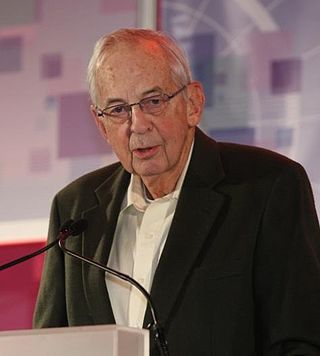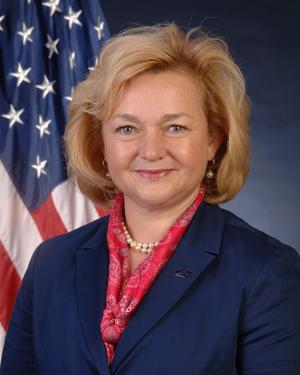Related Research Articles

Daniel Chee Tsui is a Chinese-born American physicist. He is currently serves as the Professor of Electrical Engineering, emeritus, at Princeton University. Tsui's areas of research include electrical properties of thin films and microstructures of semiconductors and solid-state physics.
Noemie Benczer Koller is a nuclear physicist. She was the first tenured female professor of Rutgers College.

Anthony Michael Johnson is an American experimental physicist, a professor of physics, and a professor of computer science and electrical engineering at the University of Maryland, Baltimore County (UMBC). He is the director of the Center for Advanced Studies in Photonics Research (CASPR), also situated on campus at UMBC. Since his election to the 2002 term as president of the Optical Society, formerly the Optical Society of America, Johnson has the distinction of being the first and only African-American president to date. Johnson's research interests include the ultrafast photophysics and nonlinear optical properties of bulk, nanostructured, and quantum well semiconductor structures, ultrashort pulse propagation in fibers and high-speed lightwave systems. His research has helped to better understand processes that occur in ultrafast time frames of 1 quadrillionth of a second. Ultrashort pulses of light have been used to address technical and logistical challenges in medicine, telecommunications, homeland security, and have many other applications that enhance contemporary life.
Elmer Samuel Imes was an internationally renowned American physicist who made important contributions in quantum, demonstrating for the first time that Quantum Theory could be applied to the rotational energy states of molecules, as well as the vibration and electronic levels, Imes' work provided an early verification of Quantum Theory, and his spectroscopy instrumentation inventions, which include one of the earliest applications of high resolution infrared spectroscopy led to development of the field of study of molecular structure through infrared spectroscopy; he was also the second African American to earn a Ph.D. in physics and the first in the 20th century. He was among the first known African-American scientists to make important contributions to modern physics, others' prior work unrecorded or uncredited. While working in industry, he gained four patents for instruments to be used for measuring magnetic and electric properties. As an academic, he developed and chaired the department of physics at Fisk University, serving from 1930 to 1941.

James Power Gordon was an American physicist known for his work in the fields of optics and quantum electronics. His contributions include the design, analysis and construction of the first maser in 1954 as a doctoral student at Columbia University under the supervision of C. H. Townes, development of the quantal equivalent of Shannon's information capacity formula in 1962, development of the theory for the diffusion of atoms in an optical trap in 1980, and the discovery of what is now known as the Gordon-Haus effect in soliton transmission, together with H. A. Haus in 1986. Gordon was a member of the National Academy of Engineering and the National Academy of Sciences.
Girsh Blumberg is an Estonian-American physicist working in the experimental physics fields of condensed matter physics, spectroscopy, nano-optics, and plasmonics. Blumberg is an elected fellow of the American Physical Society (APS), an elected Fellow of the American Association for the Advancement of Science (FAAAS) , and a Distinguished Professor of Physics at Rutgers University.
Kennedy J. Reed was an American theoretical atomic physicist in the Theory Group in the Physics & Advanced Technologies Directorate at Lawrence Livermore National Laboratory (LLNL) and a founder of the National Physical Science Consortium (NPSC), a group of about 30 universities that provides physics fellowships for women and minorities.

Ronald Elbert Mickens is an American physicist and mathematician who is the Fuller E. Callaway Professor of Physics at Clark Atlanta University. His research focuses on nonlinear dynamics and mathematical modeling, including modeling epidemiology. He also has an interest in the history of science and has written on the history of black scientists. He is a fellow of the American Physical Society and served as the historian of the National Society of Black Physicists. He has made significant contributions to the theory of nonlinear oscillations and numerical analysis.
Wolfgang Kaiser was a German physicist who worked in the fields of laser and solid-state physics.

Angela Renee Hight Walker is an American physicist. She is a project leader in the nanoscale spectroscopy group at the National Institute of Standards and Technology. Hight Walker's research includes advancing optical spectroscopic techniques and specifically their applicability to characterize quantum nanomaterials.
Karin M. Rabe is an American condensed matter and computational materials physicist known for her studies of materials near phase transitions, including ferroelectrics, multiferroics, and martensites. She also works on the theoretical design of new materials. She is a distinguished professor and Board of Governors Professor of Physics at Rutgers University.
Joseph Andrew Johnson III was an American physicist and professor at the Florida A&M University. He was a founding member of the National Society of Black Physicists. He was awarded the 1995 American Physical Society Edward Bouchet award and the 2016 Yale University Bouchet Leadership Award Medal.
James Clinton Davenport is an American physicist and physics professor. He specializes in condensed matter physics and is known for his contributions to physics education. He is one of the founders of the National Society of Black Physicists (NSBP).
Alice Elizabeth White is an American physicist. She is a professor and chair at the Boston University College of Engineering. Previously, she was Chief Scientist at Bell Labs. She is a fellow of the APS, the IEEE and the OSA.
Harold Ralph Lewis, Jr., was an American physicist, researcher at the Los Alamos National Laboratory, and professor at Dartmouth College. Lewis worked on Project Sherwood and conducted research in nuclear physics and plasma physics.
Clayton Wilson Bates, Jr., is an American physicist and electrical engineer. Bates developed an x-ray image intensifier tube for use in diagnostic radiology and was an early researcher in optical and electronic properties of nanophase metal-semiconductor composite systems. He also chartered Stanford University's Society of Black Scientists and Engineers (SBSE) in 1973.
Michael Duryea Williams is an American physicist, professor at Clark Atlanta University, and current president of the AVS: Science and Technology of Materials, Interfaces, and Processing. He is the first African American president of AVS.
Wendell Talbot Hill III is an American physicist and professor at the University of Maryland. His research career has largely focused on the intersection of laser physics and quantum science.
Harry Lee Morrison was an American theoretical physicist and the first African American physics faculty member at the University of California, Berkeley. His research focused on statistical mechanics within theoretical physics, and he was known for his demonstration in 1972 of the absence of long-range order in quantum systems in two dimensions, that was a result from the breaking of a continuous symmetry.
The Edward A. Bouchet Award is an annual prize presented by the American Physical Society (APS) to recognize distinguished physicists from underrepresented communities who have made significant contributions to research in the field of physics and for the advancement of minority scientists. The award provides a stipend of $5,000 and travel expenses for attending an APS meeting and visiting up to three institutions for talks and classroom visits.
References
- 1 2 3 4 Russell, Dick (2009-02-02). Black Genius: Inspirational Portraits of African-American Leaders. Skyhorse. ISBN 978-1-62636-646-6.
- ↑ Carwell, Hattie (1977). Blacks in Science: Astrophysicist to Zoologist. Exposition Press. ISBN 978-0-682-48911-9.
- ↑ Brown, Mitchell C. "Faces of Science: African Americans in the Sciences". Princeton.edu. Archived from the original on 10 November 2001. Retrieved 12 May 2023.
- 1 2 "Earl D. Shaw – Physicist of the African Diaspora". www.math.buffalo.edu. Retrieved 2023-05-12.
- 1 2 Shaw, Earl David (1969). Nuclear Relaxation In Ferromagnetic Cobalt (Thesis). ProQuest 302400763.[ non-primary source needed ]
- 1 2 "Shaw.bio". 2002-11-29. Archived from the original on 2002-11-29. Retrieved 2023-05-12.
- ↑ "Dare to be inspired – Charles Kopec and Dr. Earl Shaw". 2004-06-07. Archived from the original on 2004-06-07. Retrieved 2023-05-12.
- ↑ "APS Fellow Archive". www.aps.org. Retrieved 2023-05-09.
- ↑ "Alan Shaw – Computer Scientist of the African Diaspora". www.math.buffalo.edu. Retrieved 2023-05-12.